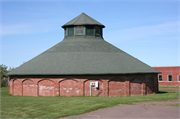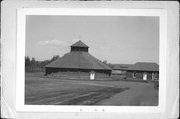Property Record
N 12TH AVE E @ Bayfront
Architecture and History Inventory
| Historic Name: | Ashland Water Utility |
|---|---|
| Other Name: | |
| Contributing: | |
| Reference Number: | 4355 |
| Location (Address): | N 12TH AVE E @ Bayfront |
|---|---|
| County: | Ashland |
| City: | Ashland |
| Township/Village: | |
| Unincorporated Community: | |
| Town: | |
| Range: | |
| Direction: | |
| Section: | |
| Quarter Section: | |
| Quarter/Quarter Section: |
| Year Built: | 1893 |
|---|---|
| Additions: | 1896 |
| Survey Date: | 19822016 |
| Historic Use: | water utility |
| Architectural Style: | Astylistic Utilitarian Building |
| Structural System: | |
| Wall Material: | Brick |
| Architect: | |
| Other Buildings On Site: | |
| Demolished?: | No |
| Demolished Date: |
| National/State Register Listing Name: | Not listed |
|---|---|
| National Register Listing Date: | |
| State Register Listing Date: |
| Additional Information: | A 'site file' exists for this property. It contains additional information such as correspondence, newspaper clippings, or historical information. It is a public record and may be viewed in person at the State Historical Society, Division of Historic Preservation. 1982: The artesian well building is architecturally significant on the state level as a rare example of a circular structure built to enclose and to pump two of the artesian wells that made Ashland's pure water famous. DESCRIPTION: This circular red brick well building in 58' 4" in diameter and the peak of the central cupola stands approximately 30' above ground level. The lead bearing brick structure extends nearly forty feet below ground level to hold approximately 740,000 gallons of 46 F water when full. Nine artesian water wells empty into the holding area at a rate of 55 gallons per minute. Above ground level, the building's exterior is articulated by a continuous series of counter arches that projects slightly from the wall. The original circular frame roof and central cupola, completely exposed in the interior, are intact. The entrance is located on the southeast side and near this the original well depth measuring equipment is still in place and operative. Inside, a metal gangway extends around the wells' interior circumference. The entire raea beneath is filled with crystal clear water in which the pipes and other equipment are visible. Light is carried in by means of the window openings in the cupola. The building survives in excellent condition. SIGNIFICANCE: The artesian well building is architecturally significant as a rare example of a circular red brick building designed in a Romanesque Revival character. The most obvious stylistic feature is the continuous arches. The survival of the original wood roof is further evidence of the building's fine integrity. Ashland was apparently in search of a healthy and large supple of drinking water, a problem that was solved by the discovery of these wells. Dr. Rinehart of Ashland pronounced "There is no purer water on Earth" in the Ashland Daily Press. The well was still used to supplement Ashland's water supply until very recently when the Department of Natural Resources ordered it closed to prevent the ground water from being mixed with surface water from Lake Superior. Current plans call for raising 5,000 young trout in the well water that would exit through pipes that empty into Lake Superior. These efforts are being coordinated through the DNR and the Apostle Islands Sport Fishing Association. 2017 report information: This municipal water utility complex consists of four structures; three of which are historic, with the fourth constructed since 2001. The oldest building is the one-story, round water reservoir which was built circa 1893 (AHI#4355). The building is recorded as measuring 58’4” in diameter, extends approximately 40’ below ground and holds approximately 740,000 gallons of water when full. Walls, which are of brick construction, feature segmental arching set within piers. The asphalt-sheathed roof supports a central, 30-foot high (above ground level) cupola that consists of alternating four-pane fixed windows and wooden, louvered venting. Adjacent to the reservoir and to the northeast is a small, one-story brick structure with a hipped roof (identified on Sanborn maps as the valve house and which was built between 1895 and 1901; AHI#234006). The visible south elevation includes a central door that is flanked by a window on either side. The third historic-era building (albeit of a later period) is the pumphouse which was added to the property in 1947 (AHI#232803). Replacing the earlier pumphouse, this structure is topped with a flat roof. A central block rises taller than the flanking blocks on the north and south; each block retains original expanses of steel-frame fenestration. A final modern brick-faced building is located along the south edge of the property. Organized by local stockholders, Ashland’s water system was initiated in 1883. By 1891, the city reported 22 miles of water mains; nearly a third of which had been installed that same year. The Ashland Daily Press Annual, 1891-1892, provided a detailed description of how the Ashland Water Works took in the water from the bay and distributed it through the city to its reported 1,050 consumers. In 1947, a new $150,000 pumphouse was built by contractor Frank Tomlinson to replace the earlier structure. The property continues to serve as the Ashland Water utility. |
|---|---|
| Bibliographic References: | ASHLAND DAILY PRESS 7/19/1988. 2017 report citations: Ashland Daily Press Annual, 1891-92, 47; Sanborn-Perris Map of Ashland, Wis., 1890, 1995; Permit for pumphouse, 3 May 1947; est. cost, $15,000. |
| Wisconsin Architecture and History Inventory, State Historic Preservation Office, Wisconsin Historical Society, Madison, Wisconsin |


